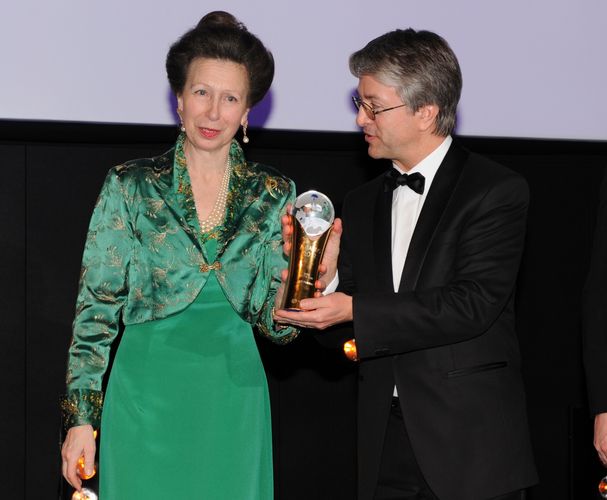
IFR Editor-at-large Keith Mullin
IFR’S ANNUAL AWARDS Gala Dinner was a spectacular success. I’m happy to engage for once in a bit of organisational self-congratulation and feel more than justified in using such superlatives to describe our own event because we raised close to £1.1m for Save the Children on the night through donations from attendees at the event – predominantly the great and the good of the global capital markets community.
Since we started hosting our awards event, investment banks and their clients have donated a total of £21.1m, which, using the average dollar-sterling exchange rate over the event’s 18-year life-cycle, equates to almost US$35m! That’s an incredible achievement.
BNP Paribas, IFR’s 2012 Bank of the Year, won the bookrunner slot on our notional issue of Guaranteed Securities for Save the Children with a wonderful winning bid of £350,000. Gracious thanks to Jean-Laurent Bonnafe, group CEO, who collected the Bank of the Year trophy from HRH Princess Anne, and Alain Papiasse, head of the corporate and investment bank.
The funds raised through the IFR dinner have made a huge difference to the lives of many many children in some of the most dangerous and impoverished parts of the world. Save the Children and organisations like it have made a lot of progress across all areas of their work, including reducing child mortality rates from preventable diseases, improving levels of school attendance and taking children out of the workplace, but the sad truth is that we still have a long way to go to eradicating levels of poverty and child suffering. So I’m taking this opportunity to thank everyone who donated so generously this year and in previous years for truly making a difference.
BEYOND THE FUNDRAISING, the great thing about the IFR awards evening is that it brings investment banks together – many with clients in tow – at the beginning of each year not just to congratulate winners from the previous year but to discuss in a convivial setting prospects for the year ahead. To the extent that you can ever glean anything from the buzz at an event, I’d say this year’s vibe clearly suggests levels of ambition and expectation for the coming year are pretty high.
I ended up speaking to a lot of people on the night and there were invariably a lot of questions about how we go about our awards process. Thinking about that got me thinking about how the investment banking landscape has changed since the 1990s and how the industry is evolving. If you think about it, investment banks had – over the years – pretty much all attempted to replicate a similar business model that was generally based on notions of being global players with a full product range and broad client base.
Banks are focusing much more on where they can perceive they can add genuine value
That being the case, it was conceptually easier to compare one investment bank with another because you could cross-check their deal flow and deal performance on a like-for-like basis, overlaying on that each year’s particular themes and adding or subtracting kudos for innovation, geographical progress, sector diversity, clients solutions, etc. It was never a simple case of looking at league tables or wallet share but the process was perhaps more one-dimensional.
These days, as regulatory and political zeal embeds itself into the strategic decision-making of banks, banks are focusing much more on where they can perceive they can add genuine value – and make money. Notions of being truly global or full-product have simply gone away for basically all but maybe a dozen – or fewer – players. That makes direct comparisons a tricky proposition.
I sense that decisions about our capital markets awards will be decided less and less on the basis of who’s intrinsically better but on the basis of an understanding of each institution’s particular story and buying that story and the success in delivering on it for clients and shareholders. That’s a much more nuanced conversation, and frankly more intellectually engaging.
THOSE OF YOU who’ve been reading my column over the past two years or so will know I’m aggressively in favour of banks sticking to their knitting and building around poles of excellence rather than being me-too players. My thinking about this was probably best summarised in a piece I wrote a year ago, a rather provocative piece entitled “The futility of being second-rate” that basically rallied against the fact that investment banking was an industry long overdue for consolidation. I wrote that some players were delusional about their ability to compete.
We’ve now seen some movement around banks exiting business – UBS in fixed income; RBS in equities and M&A – and others refocusing their business development on one or more core customer and/or product segment. But it’s not enough. Many banks still need to make some big decisions to free up capacity. It’ll make markets more efficient and ultimately provide better service to clients.
Now that corporate and investment banks are working hard on being, well, joined up CIBs rather than corporate banks and investment banks that just happen to share the same division, we’re starting to see some efforts to meld corporate banking flow products into the IB toolkit; and to transfer banking risk to the capital markets, providing a better product continuum.
That all makes sense. And it’s creating some interesting issues. As this process unfolds, you’ll get to a situation where a Goldman Sachs, say, and a BNP Paribas, say – nothing particular in this comparison – will share fewer and fewer affinities as the universal CIB model moves in a different direction and into a raft of different areas than monoline investment banking. Awards just got complicated.


